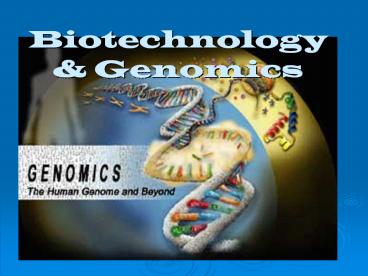Biotechnology - PowerPoint PPT Presentation
1 / 27
Title: Biotechnology
1
Biotechnology Genomics
2
DNA Cloning
- Producing identical copies through asexual means.
3
Uses
- determine genetic differences
- research purposes
- ex disease mechanism, industrial uses
- genetic modification or organisms or gene therapy
- genetic testing / crime investigation , forensics
4
Recombinant DNA (rDNA) technology
- Vector foreign DNA ex. Plasmid
- Necessary to make rDNA
- restriction enzyme sticky ends cats
specifically - DNA Ligase
- PCR, process that uses DNA polymerase
5
(No Transcript)
6
(No Transcript)
7
DNA Analysis
- DNA fingerprinting
- Cut DNA?unique band pattern
- Electrophoresis used to separate DNA by size
for analysis - RNA , Protein
8
DNA Fingerprinting Paternity
9
uses electrophoresis to move charged molecules
through a matrix
10
Biotechnology Products
- some made by genetic engineering
11
Products of genetics modification procedures
- A Transgenic bacteria uses
- Medicines, hormones, vaccines, agriculture,
industry to clean waste - B Transgenic plants
- Assist agriculture, make products
- C Transgenic animals
- Transform egg cells larger / more productive
animals - D Stem cell research
- Medicinal uses
12
(No Transcript)
13
Transgenic Mammals
14
Genomic Differences BetweenChimps Humans
15
Genomics study of genes
- Human genome project 25,000 coding genes
- Comparing genomes much similarity therefore,
possible uniqueness is caused by the regulation
of our genes - how our bodies function, how to prevent diseases,
what makes different species unique, and even how
life evolved on earth.
16
Hap Map project
- A HapMap is a catalog common sequence differences
that occur in a species - The goal of the project is to link haplotypes to
risk for specific illnesses - May lead to new methods of preventing,
diagnosing, and treating disease
17
Epigenetics DNA packaging causing expression
or no expression of genes depends on the
environmental factors one is exposed to.
18
Genetic profile the human genotype of a person
To help disease risk factors.
19
Proteomics
- Study of proteins
- Structure function of proteins to design drugs
20
Bioinformatics
- Using computers to study the genome
21
Gene Therapy
- Inserting genetic material into human cells for
the treatment of a disorder.
Ex Vivo Children with Severe Combined
Immunodeficiency Bone Marrow Stem Cells In
Vivo Cystic Fibrosis Nasal / Respiratory Spray
22
Gene TherapyHowStuffWorks Videos "Through the
Lens Gene Therapy"
HowStuffWorks Videos "The Power of Genes Gene
Therapy"
23
Study QuestionA plasmid Yip5 is cut
- Two linear fragments of 942 and 4,599 base pairs
(5,541 - 942 4,599). EcoRI and EagI - Two linear fragments of 2,003 (2,035 - 32) and
3,538 (5,541 - 2,003) base pairs. HindIII and
ApaI - Three linear fragments of 2,003, 2,881 (4,916 -
2,035), and 657 5,541 - (2,003 2,881)l base
pairs. HindIII, ApaI, and PvuI - The 942-base-pair fragment The 4,599-base-pair
fragment would be cleaved into two fragments of
2,305 (3,247 - 942) and 2,294 (4,599 - 2,305)
giving 3 total fragments. EcoRI and EagI,PvuII
Construct the plasmid
24
More Study Questions
- PCR makes gene cloning possible because it
enables lab technicians to do what very quickly? - If a plasmid is cut with a restriction enzyme 3
times how many linear fragments will it produce? - How will they be arranged on an electrophoresis
gel?
25
But wait, theres more!!
- Explain what recombinant DNA is
- If a specific DNA code is removed from a bacteria
and placed into another bacteria what is this
process called? - Why are restriction enzymes generally used in a
lab? - Dinosaur DNA has been found in very few fossils,
scientists want to compare the dino DNA to DNA of
reptiles, what technique will they use to
increase the amount of dino DNA?
26
Complete the table
Technique / tool Use
DNA polymerase
Separation of DNA fragments
DNA ligase
Restriction enzyme restriction endonuclease
Production of cDNA from mRNA
27
The Last One!!
- Explain how a gene from humans can be cloned and
produced in yeast, what process is similar































